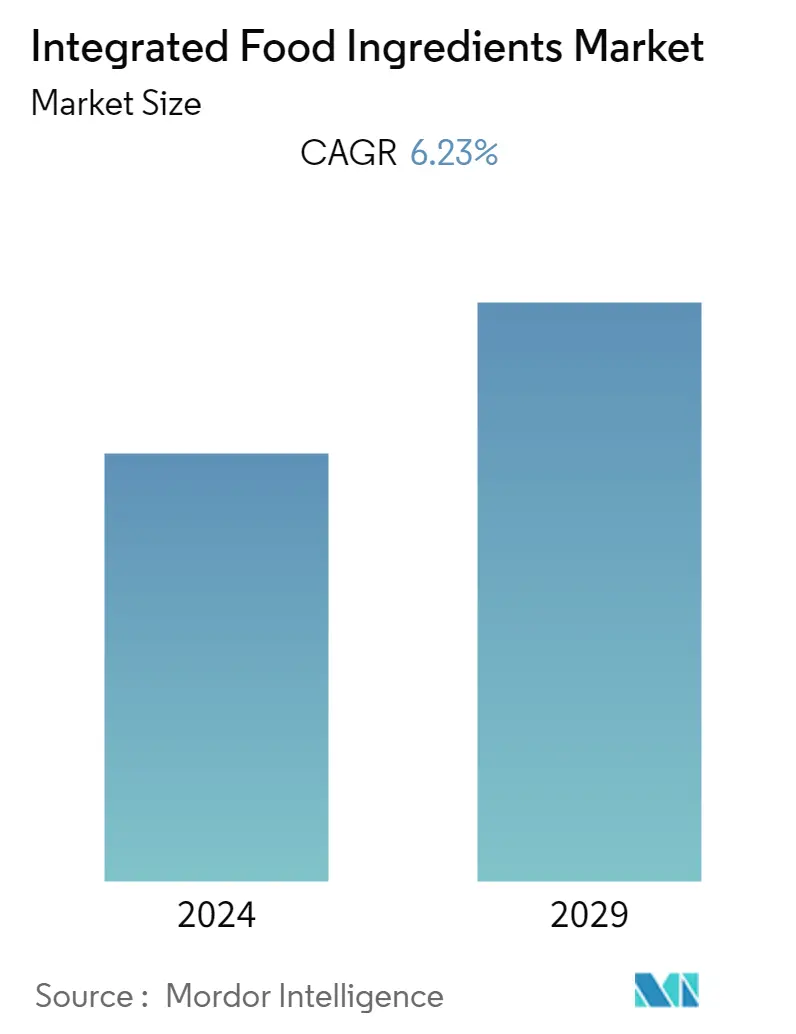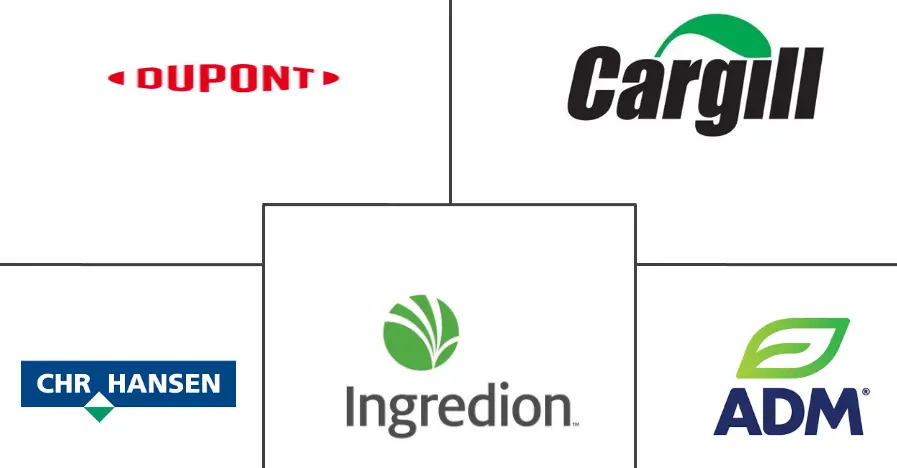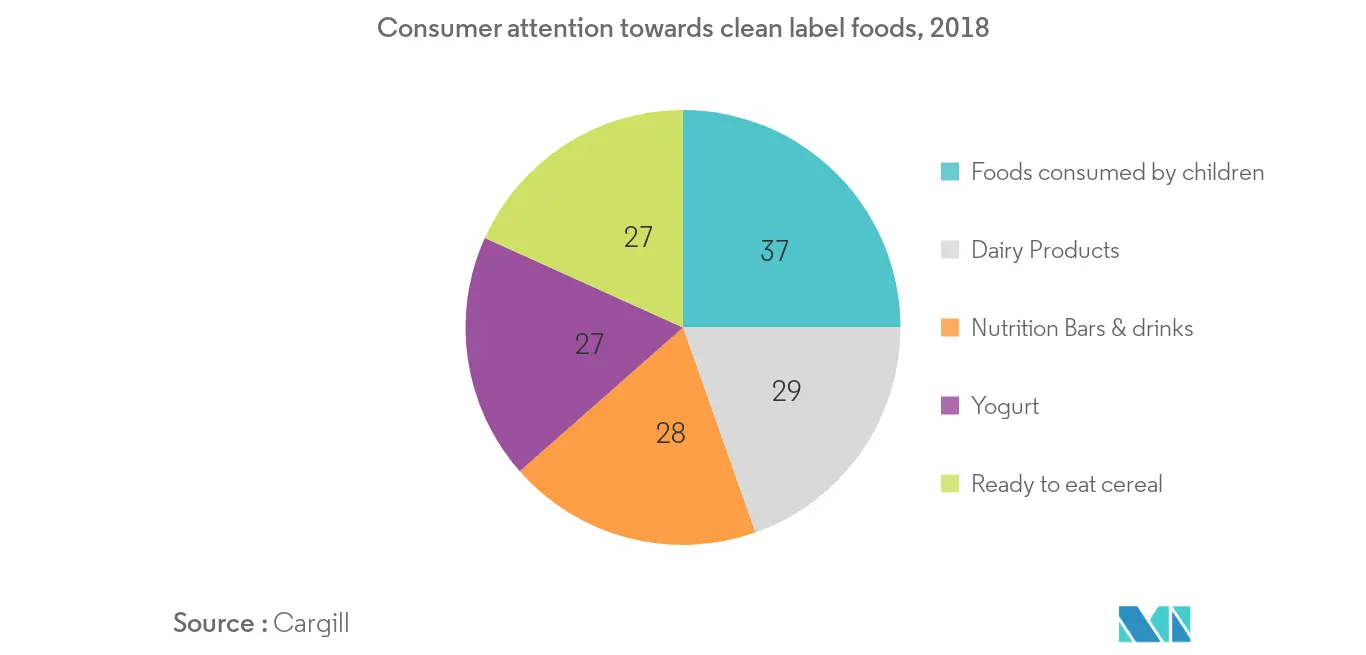Integrated Food Ingredients Market Size

| Study Period | 2019 - 2029 |
| Base Year For Estimation | 2023 |
| CAGR | 6.23 % |
| Fastest Growing Market | Asia Pacific |
| Largest Market | Europe |
| Market Concentration | High |
Major Players
*Disclaimer: Major Players sorted in no particular order |
Need a report that reflects how COVID-19 has impacted this market and its growth?
Integrated Food Ingredients Market Analysis
The integrated food ingredients market is projected to grow at a CAGR of 6.23% during the forecast period (2020-2025).
The industry for integrated food ingredients essentially thrives on the wider technological and functional benefits that these ingredients confer, in terms of high quality, safety, affordability, nutrition, and deliciousness of the processed food products. The preference for certain types of food products is now core to some consumers' identities, especially in developed economies, which is driving the demand of speciality food ingredients.
The global marketplace have witnessed significant growth in plant-based ingredients. Companies are seeking to infuse and incorporate the active principles of botanical in a wide variety of non-alcoholic beverages. Companies, such as ADM, Givaudan, Symrise, are increasingly seeking to cater to the robust demands of fruit-containing flavor systems for the beverage industry in Europe.
Integrated Food Ingredients Market Trends
This section covers the major market trends shaping the Integrated Food Ingredients Market according to our research experts:
Innovations across product offerings
The preference for certain types of food products has become core to some consumers identities. There is strong correlation between integrated food ingredient market and processed food market, with the former conferring functional benefits and customised value addition as per the end-user applications. Today's consumers are more aware of label claims and ingredient lists and their nutrition profiles.
On the other hand, consumers are taking proactive participation, to enhance health and fitness in everyday life. This trend has been driving the demand for integrated food ingredients. For instance in 2017, the sales value for probiotic products, such as yogurt and baby formula and children nutrient drink, saw maximum share of 27%, thereby validating the claim that people are increasingly consuming speciality as well as integrated ingredient infused food products.

Increasing demand for clean label and functional ingredients
With the evolving global food economy, the demand for food products with extra value is increasing significantly. There is arising preference for food products that are nutritious, cleaner, and natural. As a result, an increasing number of food manufacturers are developing food products that contain natural ingredients, along with minimal processing.
Consumers across the Latin American & European markets are highly concerned about the long-term effects of the food products they consume. This trend toward authenticity of ingredients is mounting pressure on natural key ingredients suppliers in the market. Furthermore, major manufacturers are focusing on consumer needs and preferences, including the demand for natural products.

Integrated Food Ingredients Industry Overview
Archer Daniels Midland, KONINKLIJKE DSM NV, Ingredion Incorporated, and Cargill Inc. emerged as the most active companies in the market studied with a greater number of developments recorded, primarily as product innovations followed by mergers and acquisition and partnership.
Cargill Inc.- one of the market leaders recorded largest number of product developments. The company remained focused in introducing premium culinary needs for bakery manufacturers, with exceptional formulation attributes.
Integrated Food Ingredients Market Leaders
-
Cargill Inc
-
Koninklijke DSM N.V.
-
Ingredion Incorporated
-
ADM
-
Dupont
*Disclaimer: Major Players sorted in no particular order
Integrated Food Ingredients Market Report - Table of Contents
1. INTRODUCTION
- 1.1 Study Deliverables
- 1.2 Study Assumptions
- 1.3 Scope of the Study
2. RESEARCH METHODOLOGY
3. EXECUTIVE SUMMARY
- 3.1 Market Overview
4. MARKET DYNAMICS
- 4.1 Market Drivers
- 4.2 Market Restraints
- 4.3 Opportunities
-
4.4 Porters 5 Force Analysis
- 4.4.1 Threat of New Entrants
- 4.4.2 Bargaining Power of Buyers/Consumers
- 4.4.3 Bargaining Power of Suppliers
- 4.4.4 Threat of Substitute Products
- 4.4.5 Intensity of Competitive Rivalry
5. MARKET SEGMENTATION
-
5.1 By Type
- 5.1.1 Concentrates (Juice & Milk)
- 5.1.2 Sweeteners
- 5.1.3 Flavors
- 5.1.4 Colors
- 5.1.5 Preservatives
- 5.1.6 Emulsifiers
- 5.1.7 Acidulants
- 5.1.8 Fats & Oils
- 5.1.9 Starch
-
5.2 By Application
- 5.2.1 Beverages
- 5.2.2 Snacks & Savories
- 5.2.3 Dairy Products
- 5.2.4 Meat Products
- 5.2.5 Bakery & Confectionery
-
5.3 By Geography
- 5.3.1 North America
- 5.3.1.1 United States
- 5.3.1.2 Canada
- 5.3.1.3 Mexico
- 5.3.1.4 Rest of North America
- 5.3.2 Europe
- 5.3.2.1 Spain
- 5.3.2.2 United Kingdom
- 5.3.2.3 Germany
- 5.3.2.4 France
- 5.3.2.5 Italy
- 5.3.2.6 Rest of Europe
- 5.3.3 Asia Pacific
- 5.3.3.1 China
- 5.3.3.2 Japan
- 5.3.3.3 India
- 5.3.3.4 Australia
- 5.3.3.5 Rest of Asia-Pacific
- 5.3.4 Rest of the World
- 5.3.4.1 Africa
- 5.3.4.2 Middle East
- 5.3.4.3 South America
6. COMPETITIVE LANDSCAPE
- 6.1 Most Active Companies
- 6.2 Most Adopted Strategies
- 6.3 Market Share Analysis
-
6.4 Company Profiles
- 6.4.1 BASF SE
- 6.4.2 Archer Daniels Midland Company
- 6.4.3 Koninklijke Dsm N.V
- 6.4.4 Cargill Inc
- 6.4.5 Ingredion Incorporated
- *List Not Exhaustive
7. MARKET OPPORTUNITIES AND FUTURE TRENDS
** Subject To AvailablityIntegrated Food Ingredients Industry Segmentation
The Integrated food ingredients market is segmented by type as Concentrates (Juice & Milk), Sweeteners, Flavors, Colors, Preservatives, Emulsifiers, Acidulants, Fats & Oils, and Starch, by application as Beverages, Snacks & Savories, Dairy Products, Meat Products and Bakery & Confectionery and by Geography.
| By Type | Concentrates (Juice & Milk) | |
| Sweeteners | ||
| Flavors | ||
| Colors | ||
| Preservatives | ||
| Emulsifiers | ||
| Acidulants | ||
| Fats & Oils | ||
| Starch | ||
| By Application | Beverages | |
| Snacks & Savories | ||
| Dairy Products | ||
| Meat Products | ||
| Bakery & Confectionery | ||
| By Geography | North America | United States |
| Canada | ||
| Mexico | ||
| Rest of North America | ||
| By Geography | Europe | Spain |
| United Kingdom | ||
| Germany | ||
| France | ||
| Italy | ||
| Rest of Europe | ||
| By Geography | Asia Pacific | China |
| Japan | ||
| India | ||
| Australia | ||
| Rest of Asia-Pacific | ||
| By Geography | Rest of the World | Africa |
| Middle East | ||
| South America |
Integrated Food Ingredients Market Research FAQs
What is the current Integrated Food Ingredients Market size?
The Integrated Food Ingredients Market is projected to register a CAGR of 6.23% during the forecast period (2024-2029)
Who are the key players in Integrated Food Ingredients Market?
Cargill Inc, Koninklijke DSM N.V., Ingredion Incorporated, ADM and Dupont are the major companies operating in the Integrated Food Ingredients Market.
Which is the fastest growing region in Integrated Food Ingredients Market?
Asia Pacific is estimated to grow at the highest CAGR over the forecast period (2024-2029).
Which region has the biggest share in Integrated Food Ingredients Market?
In 2024, the Europe accounts for the largest market share in Integrated Food Ingredients Market.
What years does this Integrated Food Ingredients Market cover?
The report covers the Integrated Food Ingredients Market historical market size for years: 2019, 2020, 2021, 2022 and 2023. The report also forecasts the Integrated Food Ingredients Market size for years: 2024, 2025, 2026, 2027, 2028 and 2029.
Integrated Food Ingredients Industry Report
Statistics for the 2024 Integrated Food Ingredients market share, size and revenue growth rate, created by Mordor Intelligence™ Industry Reports. Integrated Food Ingredients analysis includes a market forecast outlook to 2029 and historical overview. Get a sample of this industry analysis as a free report PDF download.

